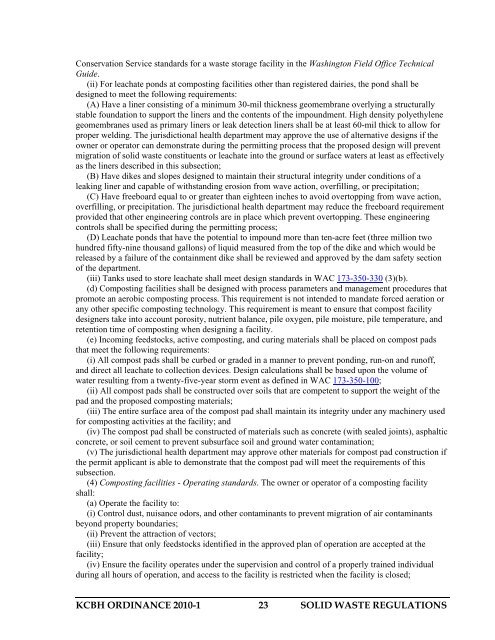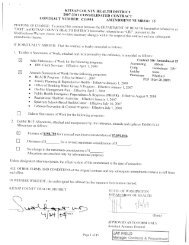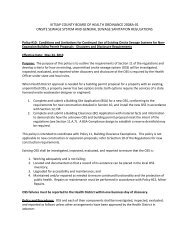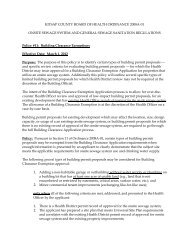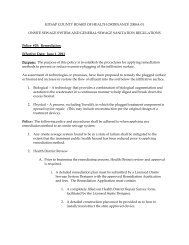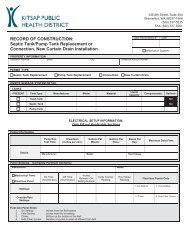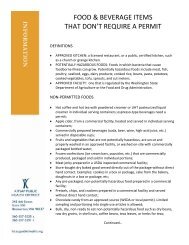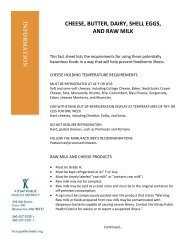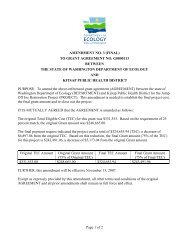SOLID WASTE REGULATIONS - Kitsap Public Health District
SOLID WASTE REGULATIONS - Kitsap Public Health District
SOLID WASTE REGULATIONS - Kitsap Public Health District
You also want an ePaper? Increase the reach of your titles
YUMPU automatically turns print PDFs into web optimized ePapers that Google loves.
Conservation Service standards for a waste storage facility in the Washington Field Office Technical<br />
Guide.<br />
(ii) For leachate ponds at composting facilities other than registered dairies, the pond shall be<br />
designed to meet the following requirements:<br />
(A) Have a liner consisting of a minimum 30-mil thickness geomembrane overlying a structurally<br />
stable foundation to support the liners and the contents of the impoundment. High density polyethylene<br />
geomembranes used as primary liners or leak detection liners shall be at least 60-mil thick to allow for<br />
proper welding. The jurisdictional health department may approve the use of alternative designs if the<br />
owner or operator can demonstrate during the permitting process that the proposed design will prevent<br />
migration of solid waste constituents or leachate into the ground or surface waters at least as effectively<br />
as the liners described in this subsection;<br />
(B) Have dikes and slopes designed to maintain their structural integrity under conditions of a<br />
leaking liner and capable of withstanding erosion from wave action, overfilling, or precipitation;<br />
(C) Have freeboard equal to or greater than eighteen inches to avoid overtopping from wave action,<br />
overfilling, or precipitation. The jurisdictional health department may reduce the freeboard requirement<br />
provided that other engineering controls are in place which prevent overtopping. These engineering<br />
controls shall be specified during the permitting process;<br />
(D) Leachate ponds that have the potential to impound more than ten-acre feet (three million two<br />
hundred fifty-nine thousand gallons) of liquid measured from the top of the dike and which would be<br />
released by a failure of the containment dike shall be reviewed and approved by the dam safety section<br />
of the department.<br />
(iii) Tanks used to store leachate shall meet design standards in WAC 173-350-330 (3)(b).<br />
(d) Composting facilities shall be designed with process parameters and management procedures that<br />
promote an aerobic composting process. This requirement is not intended to mandate forced aeration or<br />
any other specific composting technology. This requirement is meant to ensure that compost facility<br />
designers take into account porosity, nutrient balance, pile oxygen, pile moisture, pile temperature, and<br />
retention time of composting when designing a facility.<br />
(e) Incoming feedstocks, active composting, and curing materials shall be placed on compost pads<br />
that meet the following requirements:<br />
(i) All compost pads shall be curbed or graded in a manner to prevent ponding, run-on and runoff,<br />
and direct all leachate to collection devices. Design calculations shall be based upon the volume of<br />
water resulting from a twenty-five-year storm event as defined in WAC 173-350-100;<br />
(ii) All compost pads shall be constructed over soils that are competent to support the weight of the<br />
pad and the proposed composting materials;<br />
(iii) The entire surface area of the compost pad shall maintain its integrity under any machinery used<br />
for composting activities at the facility; and<br />
(iv) The compost pad shall be constructed of materials such as concrete (with sealed joints), asphaltic<br />
concrete, or soil cement to prevent subsurface soil and ground water contamination;<br />
(v) The jurisdictional health department may approve other materials for compost pad construction if<br />
the permit applicant is able to demonstrate that the compost pad will meet the requirements of this<br />
subsection.<br />
(4) Composting facilities - Operating standards. The owner or operator of a composting facility<br />
shall:<br />
(a) Operate the facility to:<br />
(i) Control dust, nuisance odors, and other contaminants to prevent migration of air contaminants<br />
beyond property boundaries;<br />
(ii) Prevent the attraction of vectors;<br />
(iii) Ensure that only feedstocks identified in the approved plan of operation are accepted at the<br />
facility;<br />
(iv) Ensure the facility operates under the supervision and control of a properly trained individual<br />
during all hours of operation, and access to the facility is restricted when the facility is closed;<br />
KCBH ORDINANCE 2010-1 23 <strong>SOLID</strong> <strong>WASTE</strong> <strong>REGULATIONS</strong>


